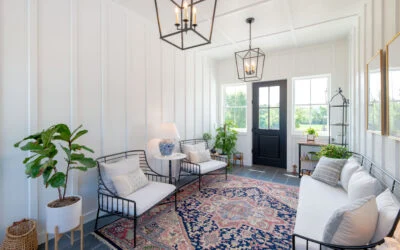There are a lot of things to consider before building a custom home. From choosing the right neighborhood for your family to designing the best floor plan for your lifestyle to selecting fixtures and finishes that fit your style, Weaver Custom Homes helps you keep track of it all.
As you start diving into the details, porch flooring ideas might not seem that important. But your new home’s outdoor living spaces deserve as much attention as the indoor rooms! After all, the exterior of your home conveys your family’s style to the world – and having a durable, beautiful, comfortable area for alfresco relaxing and entertaining is one of the many perks of going the custom route.
Part of finding a home builder you’ll love in Ohio is determining which one will guide you through all these decisions. One of the reasons we’ve been in business since the 1950s is that we take every Weaver construction project as seriously as if it were our own home being built.
To help you choose the best material for your custom home’s deck or porch, we’ve identified the most popular choices available and compared them in terms of cost, maintenance, durability and style. Read on for our seasoned insight into porch decking options that make the grade!
Types of Decking Materials
Let’s start by examining the four most popular porch decking options out there: Composite, Pressure-Treated Wood, Hardwoods and PVC.
Once you’ve got a better understanding of each, you can include specific concerns or ideas about them in the important questions to ask home builders before getting started. At Weaver Homes, we love it when our clients have questions – especially targeted questions about specific materials!
Composite
Composite flooring for porches is typically made of a combination of recycled plastic and wood chips, bamboo or another natural material. These components make composite one of the most environmentally friendly porch decking options. They also contribute to its long-term durability and low maintenance. A common complaint from homeowners who used early generations of composite was that it resembled plastic more than wood in both look and feel. But manufacturers have made great strides in those areas, so newer composite products tend to do a much better job of mimicking the texture and appearance of actual woodgrain.
Pressure-Treated Wood
Pressure-treated wood is typically made of pine or another soft wood that is treated to make it more durable. The raw lumber is infused with liquid fire-retardants and preservatives that will deter bugs and rot. Then extreme pressure is exerted on the wood, forcing the preservatives deep into its fibers before it is set aside to cure for a couple of days. The result is a cost-effective and easy-to-use product that looks like real wood – because it is – with heightened durability.
Hardwoods
Hardwoods for porch decking include exotic species like Ipe, Mahogany and Tigerwood that are highly prized for their unique beauty. Every synthetic wood product strives to mimic the intricate wood grain and nuanced coloring of hardwoods. These types of wood are naturally resistant to rot and infection, thanks to their thick, dense character. Plus, their natural tannins provide durability in much the same way as the preservatives added to pressure-treated lumber. However, there are drawbacks to this porch decking option. These tree species grow slowly in sensitive areas, like tropical forests, making them a less environmentally-friendly choice. They will also react to UV rays and weather by changing color or warping over time, and they’re susceptible to damage from moisture.
PVC
PVC stands for polyvinyl chloride, a synthetic polymer that’s also referred to simply as vinyl. This versatile material contains no wood fibers at all, but some PVC flooring for porches may contain some recycled plastic, making it more environmentally friendly. PVC is often considered the best material for a deck in rainy or coastal areas because of its excellent durability and near-total resistance to the effects of water. It’s also highly heat-resistant, which makes it surprisingly comfortable under bare feet.
Key Factors to Consider When Choosing Your Deck Material
Outdoor living areas add the most curb appeal when they dovetail with the overall exterior design of a custom home. Whether it’s a traditional colonial, a sweet Cape Cod, a rustic farmhouse or a modern ranch, you can elevate your home’s appearance by choosing flooring for porches and decks that complement its architectural style and aesthetic.
But appearance is only one factor to consider when deciding on the best material for a deck or porch. Let’s look at how each of these four options stack up in consideration of cost, maintenance, resistance to weather and color choices.
Cost
Composite – High upfront cost, but virtually no long-term maintenance costs
Pressure Treated Wood – Most inexpensive flooring for porches, but the time and cost of regular maintenance may undermine those savings in the long run
Hardwoods – Most expensive upfront pricing, and regular maintenance typically adds cost over time
PVC – Initial cost is often comparable to hardwoods, though some brands could be slightly less expensive, but this material brings long-term value because maintenance costs are virtually nil
Maintenance
Composite – Typically, no maintenance is required apart from an occasional hose-down
Pressure-Treated Wood – Power-washing, sanding and restaining are required on a regular basis to maintain aesthetics
Hardwoods – Regular maintenance, sanding, cleaning and reapplication of stains are typically required to maintain aesthetic quality
PVC – Virtually no maintenance required apart from regular sweeping to remove debris
Climate and Weather Conditions
Composite – Virtually impervious to rot, mold and decay
Pressure-Treated Wood – Tends to split, warp or fracture after long-term exposure to the elements. May also change color from UV exposure, requiring re-application of stain to maintain a stable appearance.
Hardwoods – Susceptible to weathering and rot with long-term exposure to the elements, and natural hues can morph into silvery grays under UV rays.
PVC – Highly durable and almost completely resistant to water and the elements
Style and Color Options
Composite – Delivers the look and feel of natural wood grains with a wide variety of colors and styles available to mimic many tree species
Pressure-Treated Wood – Looks like natural wood – because it is – and accepts a wide array of stains for a tailored effect. Note that there are several grades of pressure-treated woods, and your Weaver Homes design consultant can help you choose the right one for your project.
Hardwoods – Naturally beautiful appearance that differs according to tree species. Variety is limited to types of hardwoods available.
PVC – Nearly unlimited options for colors and styles that can vary from manufacturer to manufacturer
Bringing Your Dream Deck to Life with Weaver Custom Homes
Now that you know more about your porch decking options, you’re well-equipped to move on to choosing the best porch design for your custom home. Whether you’re dreaming of a front porch that invites visitors with a welcoming vibe or a back porch that extends your living space into the great outdoors, the expert designers at Weaver Custom Homes are ready to help you bring your vision to life.
Wondering what to expect during that process? Check out the custom home build experience from our clients’ POV – you’ll see how our seasoned workmanship, top-notch communication skills and expert design savvy consistently exceed expectations. Then reach out to us! Let’s start making your dream custom home a reality today!



